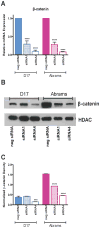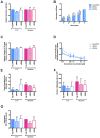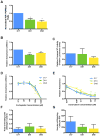β-Catenin transcriptional activity is minimal in canine osteosarcoma and its targeted inhibition results in minimal changes to cell line behaviour
- PMID: 24256430
- PMCID: PMC4029915
- DOI: 10.1111/vco.12077
β-Catenin transcriptional activity is minimal in canine osteosarcoma and its targeted inhibition results in minimal changes to cell line behaviour
Abstract
Canine osteosarcoma (OS) is an aggressive malignancy associated with poor outcomes. Therapeutic improvements are likely to develop from an improved understanding of signalling pathways contributing to OS development and progression. The Wnt signalling pathway is of interest for its role in osteoblast differentiation, its dysregulation in numerous cancer types, and the relative frequency of cytoplasmic accumulation of β-catenin in canine OS. This study aimed to determine the biological impact of inhibiting canonical Wnt signalling in canine OS, by utilizing either β-catenin siRNA or a dominant-negative T-cell factor (TCF) construct. There were no consistent, significant changes in cell line behaviour with either method compared to parental cell lines. Interestingly, β-catenin transcriptional activity was three-fold higher in normal canine primary osteoblasts compared to canine OS cell lines. These results suggest canonical Wnt signalling is minimally active in canine OS and its targeted inhibition is not a relevant therapeutic strategy.
Keywords: cell signalling; comparative oncology; in vitro models; oncology; tumour biology.
© 2013 John Wiley & Sons Ltd.
Figures




Similar articles
-
Immunohistochemical investigation of cell cycle and apoptosis regulators (survivin, β-catenin, p53, caspase 3) in canine appendicular osteosarcoma.BMC Vet Res. 2012 Jun 11;8:78. doi: 10.1186/1746-6148-8-78. BMC Vet Res. 2012. PMID: 22686277 Free PMC article.
-
Characterization of β-catenin expression in canine osteosarcoma.Vet Comp Oncol. 2011 Mar;9(1):65-73. doi: 10.1111/j.1476-5829.2010.00236.x. Vet Comp Oncol. 2011. PMID: 21303455 Free PMC article.
-
Wnt/β-catenin expression does not correlate with serum alkaline phosphatase concentration in canine osteosarcoma patients.PLoS One. 2011;6(10):e26106. doi: 10.1371/journal.pone.0026106. Epub 2011 Oct 11. PLoS One. 2011. PMID: 22022527 Free PMC article.
-
The canonical Wnt-beta-catenin pathway in development and chemotherapy of osteosarcoma.Front Biosci (Landmark Ed). 2013 Jun 1;18(4):1384-91. doi: 10.2741/4187. Front Biosci (Landmark Ed). 2013. PMID: 23747891 Review.
-
Wnt signaling in osteosarcoma.Adv Exp Med Biol. 2014;804:33-45. doi: 10.1007/978-3-319-04843-7_2. Adv Exp Med Biol. 2014. PMID: 24924167 Review.
Cited by
-
Aberrant activation of Wnt/β-catenin signaling drives proliferation of bone sarcoma cells.Oncotarget. 2015 Jul 10;6(19):17570-83. doi: 10.18632/oncotarget.4100. Oncotarget. 2015. PMID: 25999350 Free PMC article.
-
Canine sarcomas as a surrogate for the human disease.Pharmacol Ther. 2018 Aug;188:80-96. doi: 10.1016/j.pharmthera.2018.01.012. Epub 2018 Mar 9. Pharmacol Ther. 2018. PMID: 29378221 Free PMC article. Review.
-
Tumourigenic canine osteosarcoma cell lines associated with frizzled-6 up-regulation and enhanced side population cell frequency.Vet Comp Oncol. 2017 Mar;15(1):78-93. doi: 10.1111/vco.12138. Epub 2015 Feb 16. Vet Comp Oncol. 2017. PMID: 25689105 Free PMC article.
-
Novel application of single-cell next-generation sequencing for determination of intratumoral heterogeneity of canine osteosarcoma cell lines.J Vet Diagn Invest. 2021 Mar;33(2):261-278. doi: 10.1177/1040638720985242. Epub 2021 Jan 15. J Vet Diagn Invest. 2021. PMID: 33446089 Free PMC article.
References
-
- Gorlick R, Khanna C. Osteosarcoma. Journal of Bone and Mineral Research. 2010;25:683–691. - PubMed
-
- Morello E, Martano M, Buracco P. Biology, diagnosis and treatment of canine appendicular osteosarcoma: Similarities and differences with human osteosarcoma. The Veterinary Journal. 2011;189:268–277. - PubMed
MeSH terms
Substances
Grants and funding
LinkOut - more resources
Full Text Sources
Other Literature Sources

